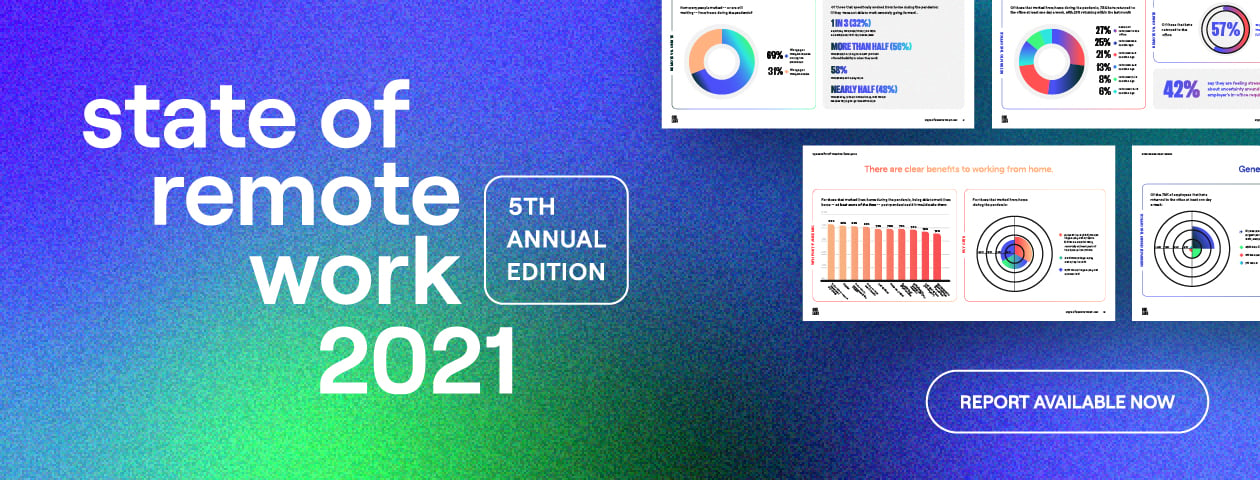When the world took part in the biggest “remote work experiment,” many cheered for the future of work. But the future of work isn’t here. It’s always… in the future.
As an authority on the future of work in the past decade, we’ve seen technology transform the workplace beyond our wildest dreams. We can only expect work will grow and change all over again.
We already know that hybrid work is here to stay. And companies are already looking forward to new solutions that will make work even better. From tech to policy to work-life balance, employees are set to succeed in new ways we can’t yet imagine.
As leaders take stock in the new normal, it’s smart to take a peek at what’s next.
What should leaders focus on in the next normal?
Working in quarantine showed us that a lot of the ways we were working weren’t effective. Without the proper preparation for hybrid work, many employees became disengaged. 1 in 2 managers who oversee remote workers are still concerned about employee engagement.
Lack of preparation isn’t an excuse now. Remote and hybrid work is the next normal—and leaders need to learn how best to shift their workplace culture.
What employees are looking for
Job-seeking
The “great resignation” is more than a buzzword. It’s real—more than 10.9 million jobs were open at the end of July 2021. And the median employee tenure in 2020 was only four years. Employees don’t have time to wait around for improvements. Business leaders need to be aware of what their employees need and make those needs their retention strategy.
From our 2021 State of Remote Work report, 90% of employees who changed jobs during the pandemic or who are actively seeking a new opportunity are looking for better career opportunities. This often means they can’t see their trajectory for growth on their team. To prevent this, every manager needs to focus on coaching their team on new skills and tools. Every 1:1 is an opportunity to instill job security and acknowledge each employee’s value.
Beyond growth, employees are prioritizing a better working environment. 88% are looking for better work-life balance and another 88% are seeking better pay. 81% of employees said they should be compensated the same whether they work in-office or remotely. And most people are looking for more flexibility in when and where they work.
Stress
With all this uncertainty comes an unprecedented amount of stress—more than this generation of workers have ever experienced. 87% of employees who are looking for new opportunities are prioritizing lower stress.
To figure out how we can counteract employee stress, we measured the top causes:
- 41% are stressed about having a meeting with their manager to request to work from home
- 38% are stressed about the uncertainty of needing to take a pay cut to work remotely
- 37% are stressed about not feeling seen or heard as a remote employee and feeling like a second citizen to in-office employees
All of these things have an easy fix: active and compassionate management. Workers want to be seen and heard without fear of retaliation. The managers who provide a culture of emotional safety will be the ones who succeed during this transition.
Top future working trends
The numbers don’t lie—employees have a clear view of what they want their next workplace to look like. Companies need to adapt to these growing needs and offer what employees are looking for. We took a look at current trends that will shape the future of work.
Most of the workers we surveyed would be interested in 10-hour or 4-day work weeks, with 53% reporting they were very interested.
84% of respondents said they would be interested in flexible policies that will not require them to be in the office at specific times. The same amount reported interest in working from anywhere.
Many of these same groups would be interested in “core hours,” or set times when everyone must be present in the physical office space. Outside these set times, those workers would log in fully flexible hours wherever and whenever works best for them.
And how do employees envision the hybrid workspace of the future? Technology could play a big role in the physical and metaphoric architecture of businesses. 68% would like to see large screens dedicated to every employee in a business. And while many are interested in working from a coworking space, others want to take it to the metaverse. Two groups, each representing 56% of our respondents, would explore working with holograms or virtual reality.
Getting on board the next normal
Most businesses are already shifting to a hybrid environment. It’s up to business leaders to adapt to this next normal or find themselves years behind the competition.
Successful companies are the ones thinking about long-term strategy rather than “let’s just survive this crisis.” It’s not about returning to normal or even embracing the new normal. It’s about forecasting how to take the lessons we’ve learned from this new normal and build what’s next. And the best way to do that is to ask the workforce what they want to see. Their answers will help us build a path to the new future of work.
%20(1).png)
Better meetings start here
From huddle rooms to boardrooms and everything in between, we’ve got you covered with solutions that take teamwork to the next level.
Shop Solutions